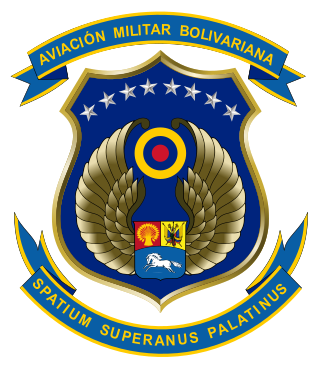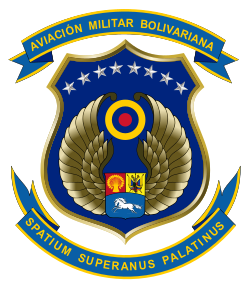Top Qs
Timeline
Chat
Perspective
Bolivarian Military Aviation of Venezuela
Aerial warfare branch of Venezuela's armed forces From Wikipedia, the free encyclopedia
Remove ads
Bolivarian Military Aviation of Venezuela (Spanish: Aviación Militar Bolivariana), is a professional armed body designed to defend Venezuela's sovereignty and airspace. It is a service component of the National Bolivarian Armed Forces of Venezuela.
Remove ads
Etymology
The organization is also known as the Bolivarian National Air Force of Venezuela. Its current official name has been in use since the end of 2008. It was previously called the Venezuelan Air Force (FAV; Spanish: Fuerza Aérea Venezolana).[2]
History
Summarize
Perspective

Most of the airbases in Venezuela were built in the 1960s as part of a massive expansion program. The main fighter types in those years were Venom, Vampire, and F-86 Sabre. Bomber squadrons typically operated B-25 Mitchell aircraft. The 1970s and 1980s saw a considerable increase in capacity, mainly because the rising oil prices enabled the FAV to re-equip most of its units. The mixture of various aircraft types was maintained, and the Mirage IIIE and Mirage 5, VF-5A and D, T-2D, OV-10A and E, and T-27 were introduced. Venezuela was one of the first export customers for the F-16 and was the first in Latin America to receive [f-16]]s, which arrived in 1983 for the newly formed Grupo Aéreo de Caza 16 at El Libertador Airbase.[3][4]
In the 1992 Venezuelan coup d'état attempts, elements of the Venezuelan Air Force were key participants in the rebellion. FAV units at El Libertador Air Base under the command of Brigadier General Visconti seized control of the airbase and then launched an attack on the capital. OV-10s, T-27s, and Mirage III fighters under Visconti's command bombarded targets in the capital and loyalist air bases, destroying five CF-5 fighters on the ground. Two loyalist pilots escaped with F-16 fighters and shot down two OV-10s and a Tucano, claiming air superiority for the government. Two more rebel OV-10s were lost to ground fire. As the tables turned on the coup attempt, General Visconti and his allies fled in two C-130s, two Mirages, an OV-10, and several SA 330 helicopters.[5]
Remove ads
Modernization



The AMV purchased 24 Sukhoi Su-30 planes from Russia in July 2006, as a result of the United States embargo on spare parts for their F-16 force.[6] In 2008, Venezuela was reported for a potential acquisition of a number of Su-35 fighter aircraft and a second batch 12–24 Sukhoi Su-30 from Russia.[7][8] The acquisition did not succeed.[9]
In 2010, the Venezuelan Air Force retired their aging F-5 fleet, the Hongdu JL-8 taking its place after being received earlier that year. [10][11]
In October 2015, Venezuela announced a plan to purchase 12 more Su-30MK2 from Russia for $480 million.[12][unreliable source?][13]
Inventory
Remove ads
Ranks
Commissioned officer ranks
The rank insignia of commissioned officers.
Other ranks
The rank insignia of Venezuelan non-commissioned officers and enlisted personnel.
Remove ads
Accidents
- On 3 September 1976, a Lockheed C-130H owned and operated by the Venezuelan Air Force crashed near Lajes Airbase, Azores, Portugal, killing all 68 occupants onboard.[18]
References
Bibliography
External links
Wikiwand - on
Seamless Wikipedia browsing. On steroids.
Remove ads























